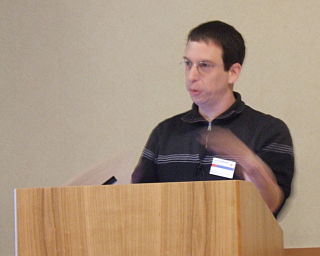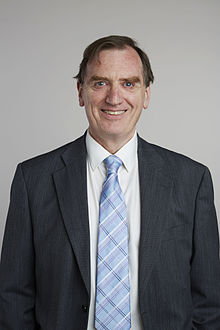
In cryptography, a cipher is an algorithm for performing encryption or decryption—a series of well-defined steps that can be followed as a procedure. An alternative, less common term is encipherment. To encipher or encode is to convert information into cipher or code. In common parlance, "cipher" is synonymous with "code", as they are both a set of steps that encrypt a message; however, the concepts are distinct in cryptography, especially classical cryptography.

Cryptanalysis refers to the process of analyzing information systems in order to understand hidden aspects of the systems. Cryptanalysis is used to breach cryptographic security systems and gain access to the contents of encrypted messages, even if the cryptographic key is unknown.
In cryptography, key size or key length refers to the number of bits in a key used by a cryptographic algorithm.

Diffie–Hellman (DH) key exchange is a mathematical method of securely exchanging cryptographic keys over a public channel and was one of the first public-key protocols as conceived by Ralph Merkle and named after Whitfield Diffie and Martin Hellman. DH is one of the earliest practical examples of public key exchange implemented within the field of cryptography. Published in 1976 by Diffie and Hellman, this is the earliest publicly known work that proposed the idea of a private key and a corresponding public key.

In cryptography, encryption is the process of encoding information. This process converts the original representation of the information, known as plaintext, into an alternative form known as ciphertext. Ideally, only authorized parties can decipher a ciphertext back to plaintext and access the original information. Encryption does not itself prevent interference but denies the intelligible content to a would-be interceptor.

Public-key cryptography, or asymmetric cryptography, is the field of cryptographic systems that use pairs of related keys. Each key pair consists of a public key and a corresponding private key. Key pairs are generated with cryptographic algorithms based on mathematical problems termed one-way functions. Security of public-key cryptography depends on keeping the private key secret; the public key can be openly distributed without compromising security.
RSA (Rivest–Shamir–Adleman) is a public-key cryptosystem, one of the oldest widely used for secure data transmission. The initialism "RSA" comes from the surnames of Ron Rivest, Adi Shamir and Leonard Adleman, who publicly described the algorithm in 1977. An equivalent system was developed secretly in 1973 at Government Communications Headquarters (GCHQ), the British signals intelligence agency, by the English mathematician Clifford Cocks. That system was declassified in 1997.

Ronald Linn Rivest is a cryptographer and computer scientist whose work has spanned the fields of algorithms and combinatorics, cryptography, machine learning, and election integrity. He is an Institute Professor at the Massachusetts Institute of Technology (MIT), and a member of MIT's Department of Electrical Engineering and Computer Science and its Computer Science and Artificial Intelligence Laboratory.
Articles related to cryptography include:
Identity-based encryption (IBE), is an important primitive of identity-based cryptography. As such it is a type of public-key encryption in which the public key of a user is some unique information about the identity of the user. This means that a sender who has access to the public parameters of the system can encrypt a message using e.g. the text-value of the receiver's name or email address as a key. The receiver obtains its decryption key from a central authority, which needs to be trusted as it generates secret keys for every user.
Cryptography, the use of codes and ciphers to protect secrets, began thousands of years ago. Until recent decades, it has been the story of what might be called classical cryptography — that is, of methods of encryption that use pen and paper, or perhaps simple mechanical aids. In the early 20th century, the invention of complex mechanical and electromechanical machines, such as the Enigma rotor machine, provided more sophisticated and efficient means of encryption; and the subsequent introduction of electronics and computing has allowed elaborate schemes of still greater complexity, most of which are entirely unsuited to pen and paper.
James Henry Ellis was a British engineer and cryptographer. Born in Australia but raised and educated in Britain, Ellis joined GCHQ in 1952. He worked on a number of cryptographic projects, but is credited with some of the original thinking that developed into the field of Public Key Cryptography (PKC).
In cryptography, a semantically secure cryptosystem is one where only negligible information about the plaintext can be feasibly extracted from the ciphertext. Specifically, any probabilistic, polynomial-time algorithm (PPTA) that is given the ciphertext of a certain message , and the message's length, cannot determine any partial information on the message with probability non-negligibly higher than all other PPTA's that only have access to the message length. This concept is the computational complexity analogue to Shannon's concept of perfect secrecy. Perfect secrecy means that the ciphertext reveals no information at all about the plaintext, whereas semantic security implies that any information revealed cannot be feasibly extracted.
Malcolm John Williamson was a British mathematician and cryptographer. In 1974 he developed what is now known as Diffie–Hellman key exchange. He was then working at GCHQ and was therefore unable to publicise his research as his work was classified. Martin Hellman, who independently developed the key exchange at the same time, received credit for the discovery until Williamson's research was declassified by the British government in 1997.

Dan Boneh is an Israeli–American professor in applied cryptography and computer security at Stanford University.

Cryptography, or cryptology, is the practice and study of techniques for secure communication in the presence of adversarial behavior. More generally, cryptography is about constructing and analyzing protocols that prevent third parties or the public from reading private messages. Modern cryptography exists at the intersection of the disciplines of mathematics, computer science, information security, electrical engineering, digital signal processing, physics, and others. Core concepts related to information security are also central to cryptography. Practical applications of cryptography include electronic commerce, chip-based payment cards, digital currencies, computer passwords, and military communications.
The following outline is provided as an overview of and topical guide to cryptography:
Identity-based cryptography is a type of public-key cryptography in which a publicly known string representing an individual or organization is used as a public key. The public string could include an email address, domain name, or a physical IP address.
The Sakai–Kasahara scheme, also known as the Sakai–Kasahara key encryption algorithm (SAKKE), is an identity-based encryption (IBE) system proposed by Ryuichi Sakai and Masao Kasahara in 2003. Alongside the Boneh–Franklin scheme, this is one of a small number of commercially implemented identity-based encryption schemes. It is an application of pairings over elliptic curves and finite fields. A security proof for the algorithm was produced in 2005 by Chen and Cheng. SAKKE is described in Internet Engineering Task Force (IETF) RFC 6508.








